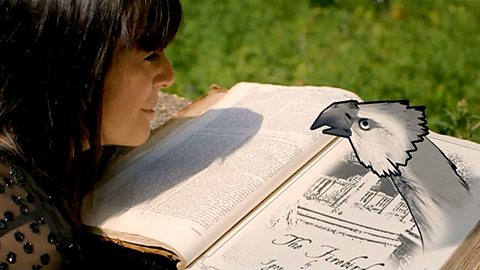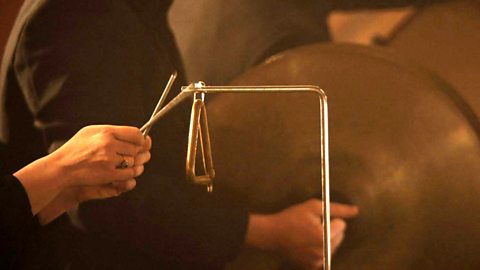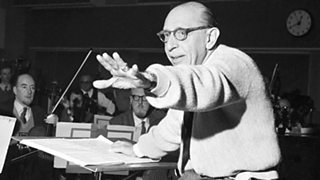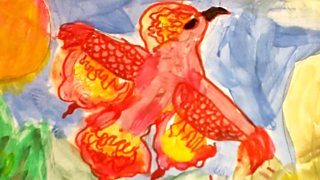The Firebird – suite (1911) (Finale) by Igor Stravinsky

Claudia Winkleman introduces Stravinsky's The Firebird
Learn the story behind Stravinsky's Firebird in this beautiful clip with animation.
Igor Stravinsky was a Russian composer, pianist and conductor. He became internationally famous when his ballet The Firebird was premiered in Paris in 1910. Stravinsky was so proud of his composition that he later made it into an orchestral suite for performance in the concert hall without dancers.
Stravinsky's piece is based on a Russian folk tale about a magical glowing bird that Prince Ivan is searching for. The firebird is imprisoned in a castle with a beautiful princess. Ivan rescues the bird and the princess but then his own sister poisons him and the princess. Luckily the firebird flies to the fountain of youth and with magic water brings Prince Ivan and his beloved princess back to life.
Listen out for: The serene horn solo at the beginning then the harps come in. Gradually all of the instruments come in and the piece gets louder and louder. A great finale for a ballet because the audience leave with the music ringing in their ears.
Watch the introduction film at the top of the page then starting exploring the music:
Watch the full orchestral performance
Watch the full performance of The Firebird, played by the BBC National Orchestra of Wales and conducted by Thomas Søndergård:
MP3s: Listen to or download the music
Download the Firebird – suite (1911) (Finale) MP3
You can also download the Firebird orchestral backing track
Or download the Firebird piano accompaniment
(PC: right click, Mac: ctrl-click)
Performed by the BBC National Orchestra of Wales
Lesson plans: Activities and exercises
Download classroom lesson plans to explore Stravinsky's music (available as PDFs).
To save to your computer: PC - right-click and save, Mac - ctrl-click and save.
Primary lesson plans:
- Stravinsky lesson plan
- How to make a creative response
- Lesson plan to accompany the teaching resource film
Suitable for:
- Key Stage 2 in England and Wales
- Second Level, P5-P7 in Scotland
- Key Stage 1/Key Stage 2 in Northern Ireland
Lesson plan 1 written by Ann Barkway. Lesson plan 2 written by Andrew Smith. Lesson plan 3 written by Rachel Leach.
Arrangements: Play the piece with simplified parts
All parts have been designed to work together to enable mixed-ability groups to perform together
Beginner/pre-Grade 1
- Violin (open strings) | Cello/Double bass (open strings)
- Flute | Clarinet in Bb | Oboe (or any mid-range instrument in C) | Bassoon
- Trumpet in Bb | Horn in F (F and Bf fingering) | Trombone (or other bass instrument in C)
- Tenor horn/Alto sax in Eb | Euphonium/Baritone
- Bass (or any large) drum | Glockenspiel
- Piano beginner
- Transposed score
Grade 1-3
- Violin | Cello/Double bass
- Flute | Clarinet in Bb | Oboe (or any mid-range instrument in C) | Bassoon
- Trumpet in Bb | Trombone (or any bass instrument in C) | Horn in F
- Tenor horn/Alto sax in Eb | Euphonium/Baritone
- Bass (or other large) drum
- Piano
- Intermediate score
Grade 4-5
- Violin | 2nd Violin (based on viola) | Viola | Cello | Double bass
- Flute | Clarinet in Bb | Oboe | Bassoon
- Trumpet in Bb | Trombone (bass clef) | Trombone (treble clef) | Horn in F | Tenor horn/Alto sax in Eb
- Euphonium/Baritone | Bass in Bb | Bass in Eb (treble clef) | Tuba
- Bass drum
- Full score | Piano accompaniment
Combined score
© 1911 SCHOTT MUSIC GMBH & CO. KG, MAINZ, GERMANY, WORLDWIDE RIGHTS EXCEPT FOR UNITED KINGDOM, IRELAND, AUSTRALIA, CANADA, SOUTH AFRICA AND ALL SO-CALLED REVERSIONARY RIGHTS TERRITORIES WHERE THE COPYRIGHT © 1996 IS HELD JOINTLY BY SCHOTT MUSIC GMBH & CO. KG, MAINZ, GERMANY AND CHESTER MUSIC LTD
Arrangements: Background notes
From the arrangers:
Notes on pre-Grade 1 and Grade 1-3 parts (Written by from Andrew Smith)
All the beginner and Grade 1-3 arrangements are short excerpts of the work named in the title and complement the Grade 4-5 arrangements. This enables you to involve players of different abilities in one ensemble, all performing the same piece.
Where as the Grade 4-5 arrangements are around 3 minutes each, the beginner parts are between 60-90 secs, allowing for the stamina of a young musician who is used to playing pieces of similar duration.
The beginner and intermediate arrangements have been orchestrated for many different instruments, from flute to ukulele, however many different combinations of instruments can be used, even if your school has one or more that is not listen in the score!
The standard of playing for the beginner parts is based around the first few notes I'd expect the musician to learn, and basic semibreve, minim, crotchet, quaver rhythms. As much as possible, I have also tried to move to adjacent notes/strings, thus avoiding big leaps. The standard of playing for the intermediate parts is based around ABRSM Grade 1-3.
In most cases, the Grade 4-5 optional piano accompaniment parts will fill in any gaps, and will be useful for rehearsals or even in performance alongside an ensemble performing entire beginner and/or intermediate parts.
Notes on Grade 4-5 parts (Written by arranger Gareth Glyn)
All the arrangements present a short (3-minute) excerpt or abridgment of the work named in the title, and have been conceived in such a way that many different combinations of instruments can be successfully employed in playing them, even if your school hasn't got one or more of the instruments shown on the score.
The standard of playing necessary is about ABRSM Grades 4/5, though some parts may be marginally easier or trickier in places. Alternative notes have been provided for some more challenging situations.
In most cases, the optional piano accompaniment will fill any gaps, and may well be useful for rehearsals, though in most cases it would be best to do without it for performance, if possible.
Notes on orchestration
Below, in bold print, are the instruments named on the score, followed in bold print by other instruments which can play the same part.
Flutes - This line can also be played by violins. Because of the range of the flute, violinists attempting this line will find themselves playing in the higher positions. Violins also have their own dedicated part, so it's suggested that that part should have sufficient instruments on it before any are put on the flute line.
Oboes - Any mid-range C instruments (i.e. instruments which play the written pitch) can play from this stave. This would include violins, recorders and flutes (especially if there is a surplus, after having placed some on the dedicated flute line).
Clarinets in Bb - Other than soprano saxophones, which are highly unlikely to be found in a school orchestra, there are no obvious contenders to join the clarinets on this line. The writing, and the range, will generally be unsuitable for at-pitch Bb instruments such as the trumpet or cornet; and lower Bb instruments such as the euphonium shouldn't use this part as the sound will be muddied by the lower octave.
Bassoons - Cellos can play from this part (though in the first instance they should use their dedicated part).
Horns in F - This being a demanding instrument, rather rare in the school orchestra, it is generally doubled in the arrangements by the tenor horn in Eb, which has its own stave and part (see below).
Tenor Horns in Eb and alto saxophones - These play from the same part, which generally doubles the part of the F horn (see above). There is, if required, a part for 2nd Horn in F, which duplicates that of the Tenor Horn.
Trumpets in Bb - Their part can be played by cornets.
Trombones - The trombone part is available in two notations - bass clef at pitch and treble clef (brass band notation). The former part can also be used by cellos (though they have their own dedicated stave too); the latter by euphoniums and baritones (ditto).
Euphoniums and Baritones - Any spare trombones may be allotted this stave. A part in bass clef for this line is also provided; it's called '2nd trombone'.
Bass in Bb - The part for this instrument is also provided in bass clef, for the orchestral tuba. A separate part is provided for the smaller Eb bass; the music is identical in pitch, except for the odd occasion where an upwards octave transposition has been necessary.
Percussion - The name for this varies from piece to piece, but it is generally for any kind of large drum. If the part is called 'timpani', then of course those tuned drums should ideally be employed, but any percussive instrument will usually be quite effective. The percussion parts of all the pieces can be executed by one player, except for the Adams, which has a quick change in the middle; however, in this case, the instrument used at the start can just as well be used right through.
Violins - This part could be doubled by flutes or oboes if there are enough of them to go around. Players who aren't comfortable out of 1st position should consider an alternative (see below).
Violas - These aren't particularly prevalent in school orchestras, so a special violin part is provided. It's called 2nd violin, and is identical to the viola part except for passages which go below low G – these are either omitted in the special part or transposed upwards.
Cellos - Their part can be played by bassoons, though they should in the first instance be placed on their dedicated line.
Double Basses - Any other bass-clef C instrument (bassoons, cellos and the like) playing from this part will be doubling it an octave higher; this will do no harm at all, and often it would be better to have something on this line than nothing at all.
Watch the full performance

Full orchestral performance: The Firebird - suite (1911) (Finale)
Watch a full orchestral performance of Stravinsky's piece.
Additional resources
About the composer
IGOR STRAVINSKY

BORN: 1882 / DIED: 1971 / NATIONALITY: Russian
Igor Stravinsky was born in Russia in 1882. His dad was a singer with the St Petersburg Opera and from a very young age Igor knew he wanted to be a musician when he grew up. Stravinsky in fact grew up to be one of the most important and influential composers of the 20th Century. He was also a bit of a musical chameleon, changing his musical style every few years to fit each new challenge. He first became famous in Paris in the 1910s writing vivid and exciting ballets, one of which caused a full-scale riot in the audience on opening night and catapulted him to fame. Later in his life he wrote music that sounded like it had come from centuries before (neo-classical) and at the end of his life in 1971 he was in Hollywood, writing the occasional film score in between living the life of a celebrity. Stravinsky's unique sound changed music forever and his early Parisian ballets still inspire younger musicians.










